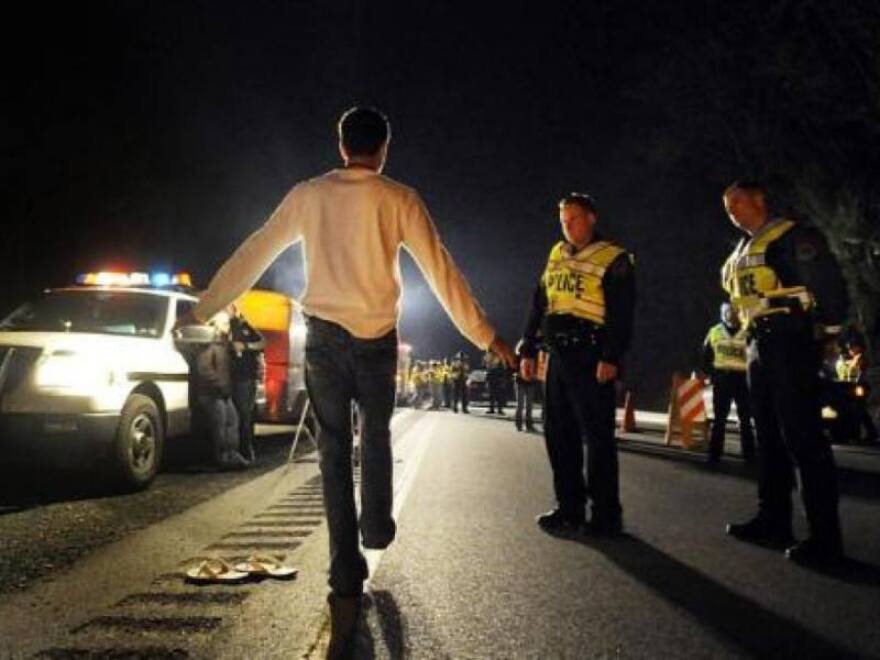When recreational pot first became legal in Colorado, the state’s Department of Transportation released a series of tongue-in-cheek public awareness ads. In one, a cartoonishly high man installs a new TV in his living room, but gets distracted by nearby snacks.
He wanders towards the chips and salsa, leaving the partially-installed flat screen unattended. Predictably, the TV slips from its spot on the wall and hits the ground in a thunderous crash.
The man, sobered by the jolt, realizes his mistake. At the same time, bold, white font appears in the frame.
“Installing your TV while high is now legal,” it reads. Followed by, “Driving to get a new one isn’t.”
The ad was among the first of CDOT’s many public awareness campaigns that have tried and failed to lower the number of fatal car accidents involving Coloradans with active THC in their blood.
Last August, the department released data from 2016 that tallied 77 traffic deaths involving high drivers. Since 2013, that number has risen sharply each year. Officials expect it to continue creeping upward.
Despite laws against driving high and millions of dollars of state tax revenue put toward public awareness campaigns, people continue to do it. CDOT, which lists one of its primary missions as, “reducing the incidence and severity of motor vehicle crashes and the associated human and economic losses,” has no idea why.
“What is it about driving high that people feel like it is safe to do?” Sam Cole, a department spokesman, said. “[Your] perception is off, your judgement is off and it makes you an unsafe driver.”

Delta 9-THC, the psychoactive component of cannabis, can impede a driver’s perception of time, distance and speed, according to CDOT and multiple studies and reports on the issue . Even in a weed-friendly state like Colorado, an average of 60 people are arrested in Colorado each day for driving under the influence of drugs or alcohol.
A 2016 survey conducted on marijuana smokers showed 55 percent of respondents said they believed it was safe to drive while high.
To get that number down, CDOT says it is putting nearly a million dollars this year toward developing a new ad campaign aimed directly at smokers. It will work with the marijuana industry directly, host community meetings, conduct surveys and give presentations around the state.
It is also funneling hundreds of thousands of dollars to the Colorado State Patrol to help identify areas in the state in need of additional DUI checkpoints.
“We’ve been talking about driving drunk in this country for the last 20 or 30 years,” Cole said. “We just aren’t having that same conversation about driving high.”
Cole said the goal of the department’s new effort, which it calls, “the Cannabis Conversation,” is to develop an understanding of why smokers drive high to inform its future messaging efforts.
“We’re kind of taking a year off from our normal ‘Drive High, Get A DUI’ advertising campaign,” he said.
Cole said the department is already attending concerts with information. It will also be present at the Denver Auto Show in April to discuss driving high.

In a statement, Shannon Brooks, vice president of marketing for Lightshade Dispensaries, said two-way communication about driving high is important.
“Better understanding this issue can ultimately improve the safety of our customers and the general public — something that is of utmost concern to us,” she said. “We also think it’s important to educate cannabis consumers to the dangers of driving high — and feel strongly that the message needs to be delivered in a way that’s well-received and can change behaviors.”
The rise in high driver fatalities was just a fraction of the state’s nearly 30 percent overall increase in traffic deaths last year. Darrell S. Lingk, director of the Office of Transportation Safety and Charles E. Meyer, manager of the Traffic and Safety Engineering Branch, in CDOT’s most recent strategic safety plan, attributed the trend to a myriad of causes.
“With the legalization of marijuana, more and more technology causing distractions, climate change, low gas prices, a thriving local economy, and increasing population density in front range counties, there are many factors which play a part in the increased fatal crashes,” they wrote.
Preliminary data from CDOT released last month showed 630 traffic fatalities in Colorado last year, up from 488 in 2014. That figure includes pedestrians, motorcyclists, bicyclists, passengers and drivers.



